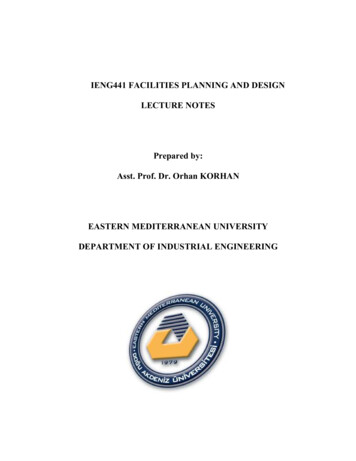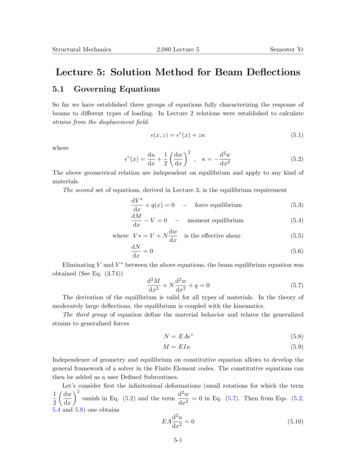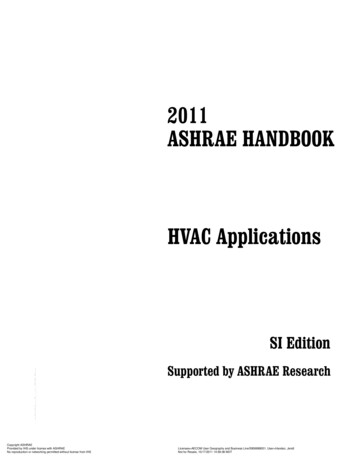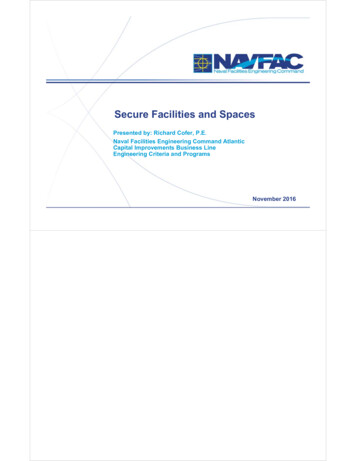
Transcription
IENG441 Facilities Planning&Design,Department of Industrial Engineering,Eastern Mediterranean UniversityIENG441 FACILITIES PLANNING AND DESIGNLECTURE NOTESPrepared by:Asst. Prof. Dr. Orhan KORHANEASTERN MEDITERRANEAN UNIVERSITYDEPARTMENT OF INDUSTRIAL ENGINEERING0Prepared by: Asst. Prof. Dr. Orhan Korhan
IENG441 Facilities Planning&Design,Department of Industrial Engineering,Eastern Mediterranean UniversityCHAPTER 1FACILITIESFacilities can be broadly defined as buildings where people, material, andmachines come together for a stated purpose – typically to make a tangible product orprovide a service.The facility must be properly managed to achieve its stated purpose whilesatisfying several objectives.Such objectives include producing a product or producing a service at lower cost, at higher quality, or using the least amount of resources.1.1. Definition of Facilities Planning1.1.1. Importance of Facilities Planning & DesignManufacturing and Service companies spend a significant amount of time andmoney to design or redesign their facilities. This is an extremely important issue andmust be addressed before products are produced or services are rendered.A poor facility design can be costly and may result in: poor quality products, low employee morale, customer dissatisfaction.1.1.2. Disciplines involved in Facilities Planning (FP):Facilities Planning (FP) has been very popular. It is a complex and a broadsubject.Within the engineering profession: civil engineers, electrical engineers, industrial engineers, mechanical engineers are involved in FP.Additionally, architects, consultants,1Prepared by: Asst. Prof. Dr. Orhan Korhan
IENG441 Facilities Planning&Design, Department of Industrial Engineering,Eastern Mediterranean Universitygeneral contractors,managers,real estate brokers, andurban planners are involved in FP.1.1.3. Variety of Facility Planning (FP) Tools:Facility Planning (FP) tools vary from checklists, cookbook type approachesto highly sophisticated mathematical modeling approaches.In this course, a practical approach to facilities planning will be employedtaking advantage of empirical and analytical approaches using both traditional andcontemporary concepts.1.1.4. Applications of Facilities Planning (FP):Facilities Planning (FP) can be applied to planning of: a new hospital, an assembly department, an existing warehouse, the baggage department in an airport, department building of IE in EMU, a production plant, a retail store, a dormitory, a bank, an office, a cinema, a parking lot, or any portion of these activities etc Facilities Planning (FP) determines how an activities tangible fixed assets bestsupport achieving the activity’s objectives.i.e. what is the objective of the facility? How the facility achieves that objective? In the case of a manufacturing firm:Facilities Planning (FP) involves the determination of how the manufacturingfacility best supports production. In the case of an airport:Facilities Planning (FP) involves determining how the airport facility is tosupport the passenger-airplane interface. In the case of a hospital:Facilities Planning (FP) for a hospital determines how the hospital facilitysupports providing medical care to patients.2Prepared by: Asst. Prof. Dr. Orhan Korhan
IENG441 Facilities Planning&Design,Department of Industrial Engineering,Eastern Mediterranean UniversityFacilities Planner considers the facility as a dynamic entity. Therefore continuousimprovement is an integral element of FP cycle.Figure 1.1. Continuous improvement facilities planning cycleIt is important to recognize that we do not use the term facilities planning as asynonym for such related terms as facilities location, facilities design, facilities layout,or plant layout. It is convenient to divide a facility into its location and designcomponents.3Prepared by: Asst. Prof. Dr. Orhan Korhan
IENG441 Facilities Planning&Design,Department of Industrial Engineering,Eastern Mediterranean UniversityFacilities Planning Facility LocationFacilities DesignFacilities LayoutPlant LayoutFacilities Planning Hierarchy:1.1.5. Facilities Location (Macro Aspect of FP):Location of the facility refers to its placement with respect to customers,suppliers, and other facilities with which it interfaces.1.1.6. Facilities Design (Micro Aspect of FP):Design components of a facility consists of the facility systems, the layout andthe handling systems.Facilities Systems:Consists of the structural systems, the atmospheric systems, thelighting/electricity/communication systems, the life safety systems and thesanitation systems.Layout:Consists of all equipment, machinery and furnishings within thebuilding.Handling Systems:Consists of the mechanism need to satisfy the required facilityinteractions.e.g. for a manufacturing system:4Prepared by: Asst. Prof. Dr. Orhan Korhan
IENG441 Facilities Planning&Design, Department of Industrial Engineering,Eastern Mediterranean UniversityFacility Systems – the structure (of building), power, light, gas, heat,ventilation, air-conditioning, water and sewage needs.Layout – the production areas, related support areas, personnel areas.Handling Systems – the materials- personnel, information, andequipment to support manufacturing.1.1.7. Application of FP Hierarchy to a Number of DifferentTypes of Facilities:FP Hierarchy:Facilities Planning for specific types of facilities:a)b)c)d)Manufacturing plantOfficeHospitalEmergency room5Prepared by: Asst. Prof. Dr. Orhan Korhan
IENG441 Facilities Planning&Design,Department of Industrial Engineering,Eastern Mediterranean UniversityFigure 1.3. Facilities planning for specific types of facilities1.2. Significance of Facilities PlanningTo understand the significance of Facilities Planning (FP) consider the followingquestions: What impact does facilities planning have on handling and maintenance cost?What impact does facilities planning have on employee morale, and how doesemployee morale impact operating costs?6Prepared by: Asst. Prof. Dr. Orhan Korhan
IENG441 Facilities Planning&Design, Department of Industrial Engineering,Eastern Mediterranean UniversityIn what do organizations invest the majority of their capital, and howconvertible is their capital once invested?What impact does facilities planning have on the management of a facility?What impact does facilities planning have on facility’s capability to adapt tochange and satisfy future requirements?1.3. Objectives of Facilities PlanningObjectives of FP is to plan a facility that achieves both facilities location and designobjectives.1.3.1. Objectives of Industrial Facility Location:Objective of Industrial Facility Location is to determine the location which, inconsideration of all factors affecting deliver-to-customers cost of the products to bemanufactured, will be minimized.1.3.2.Some Typical Facilities Design Objectives are to:1. Support the organization’s vision through improved material handling,material control, and good housekeeping.2. Effectively utilize people, equipment, space and energy.3. Minimize capital investment.4. Be adaptable and promote ease of maintenance.5. Provide for employee safety and job satisfaction.1.4. Facilities Planning ProcessAlthough facility is planned only once, it is frequently replanned to synchronize thefacility and its constantly changing objectives. Planning and Replanning are linked bythe continuous improvement FP cycle (Figure 1).FP is not an exact science, but it can be approached using an organized and systematicapproach.Traditionally, the ENGINEERING DESIGN PROCESS (EDP) can be applied(similar to problem solving approach).It consists of following 6 steps: Define the problem, Analyze the problem, Generate alternative designs, Evaluate the alternatives, Select the preferred design, Implement the design.7Prepared by: Asst. Prof. Dr. Orhan Korhan
IENG441 Facilities Planning&Design,Department of Industrial Engineering,Eastern Mediterranean UniversityApplying the engineering design process to facilities planning results in the followingprocess:1. Define (or redefine) the objective of the facility,2. Specify the primary and support activities to be performed in accomplishingthe objective.Requirements in terms of: Operations, Equipment, Personnel, Material flows should be satisfied.3.4.5.6.Determine the interrelationships among all activities,Determine the space requirements for all activities,Generate alternative facilities plans,Evaluate alternative facilities plans (alternative locations and alternativedesigns),7. Select a facilities plan,8. Implement the facilities plan,9. Maintain and adapt the facilities plan,10. Redefine the objective of the facility.An Organization’s Model of Success:Experience has shown that in order for the facilities plan to be successful, not onlya clear understanding of the vision is needed, but also the mission, the requirement ofsuccess, the guiding principles, and the evidence of success.Five elements that form an organization’s model of success: Vision: a description of where you are headed. Mission: how to accomplish the vision. Requirements of success: the science of your business. Guiding principles: the values to be used, while pursuing the vision. Evidence of success: measurable results that will demonstrate when anorganization is moving towards their vision.8Prepared by: Asst. Prof. Dr. Orhan Korhan
IENG441 Facilities Planning&Design,Department of Industrial Engineering,Eastern Mediterranean UniversityFigure 1.4. The model of success “winning circle”SUMMARY FP determines how an activity’s tangible fixed assets should contribute tomeeting the activity’s objectives.FP consists of facilities location and facilities design.Partly art, partly science.Can be approached using the engineering design process.Represents one of the most significant opportunity for cost reduction andproductivity improvement.9Prepared by: Asst. Prof. Dr. Orhan Korhan
IENG441 Facilities Planning&Design,Department of Industrial Engineering,Eastern Mediterranean UniversityCHAPTER 2FACILITIES IN THE MANUFACTURING CONTEXTIn the manufacturing context, a facility is a place where raw materials, processingequipment, and people come together to make a finished product.2.1. Logistics ManagementLogistics management can be defined as the management of the transportationand distribution of goods.Goods Raw materialsSubassemblies obtained from suppliersFinished goods shipped from plants to warehouses or customersLogistics management includes all distribution and transportation activitiesfrom suppliers through to customers.Logistics management is the management of a series of macro-leveltransportation and distribution activities with the main objective of delivering theright amount of material at the right place at the right time at the right cost using theright methods.The decisions typically encountered in logistics management concern facilitylocation, transportation and goods handling and storage.Logistics management problems can be classified into three categories:1. Location Problems:Location Problems involve determining the location of one or more newfacilities in one or more of several potential sites. The number of sites must atleast equal the number of new facilities being located.The cost of locating each new facility at each of the potential sites is assumedto be unknown.It is the fixed cost of locating a new facility at a particular site plus theoperating and transportation cost of serving customers from this facility-sitecombination.10Prepared by: Asst. Prof. Dr. Orhan Korhan
IENG441 Facilities Planning&Design,Department of Industrial Engineering,Eastern Mediterranean University2. Allocation Problems:Allocation Problems assume that the number and location of facilities areknown and attempt to determine how each customer is to be served. That is,given the demand for goods at each customer center, the production or supplycapacities at each facility, and the cost of serving each customer from eachfacility, the allocation problem determined how much each facility is to supplyto each customer center.3. Location – Allocation Problems:Location – Allocation Problems involve determining not only how much eachcustomer is to receive from each facility but also the number of facilities alongwith their locations and capacities.2.2. Classification of Facility Location ProblemsFacility Location problems can be classified as: Single-Facility Location ProblemsSingle-Facility location problems deal with the optimal determination ofthe location of a single facility. Multifacility Location ProblemsMultifacility location problems deal with the simultaneous locationdetermination for more than one facility.Generally, single-facility location problems are location problems, butmultifacility location problems can be location as well as locationallocation problems.Another classification of location problems is based on whether the set ofpossible locations for a facility is finite or infinite Continuous Space Location ProblemIf a facility can be located anywhere within the confines of a geographicarea, then the number of possible locations is infinite, and such a problemis called a Continuous Space Location Problem. Discrete Space Location ProblemDiscrete Space Location Problems have a finite feasible set of sites inwhich to locate a facility.11Prepared by: Asst. Prof. Dr. Orhan Korhan
IENG441 Facilities Planning&Design,Department of Industrial Engineering,Eastern Mediterranean UniversityBecause facilities can be located anywhere in a two-dimensional space,sometimes the optimal location provided by the continuous space model maybe infeasible. For example, a continuous space model may locate amanufacturing facility on a lake!2.3. Facility Location ProblemThe facility location problem consists of selecting a site for new facilities thatwill minimize the production and distribution cost of products and/or services topotential customers.2.3.1. Reasons for considering Location Problems Significant changes in the level of demand,Significant changes in the geographical distribution of demand,Changes in the cost or quality requirements of critical production inputs(labor, raw materials, energy or others),Significant increases in the real-estate value of existing or adjacent sites orin their taxation,Need to change as a result of fire or flood for reasons of prestige orimproved public relations.2.3.2. Alternatives to New Location The increase of existing capacity by additional shifts or overtime,especially for capital-intensive systems.The use of seasonal inventories to reduce the need for maintainingcapacity for peak demand.The use of subcontractors.The purchase of new equipment for the present location.2.3.3. Important Factors in Location Decisions Production inputs (raw materials, human resources, etc ),Process techniques,Environmental factorso The availability and reliability of supporting systemso Social and cultural conditionso Legal and political considerations.Example:Consider the NIKE distribution center in Laakdal, Belgium. This warehouse employs 800 people, It has an annual turnover of 10.5 million of units of footwear andapparel, It covers 25 acres, It cost 139 million to build.12Prepared by: Asst. Prof. Dr. Orhan Korhan
IENG441 Facilities Planning&Design,Department of Industrial Engineering,Eastern Mediterranean UniversityA location and design study was done in 1992 and the building was completedin two phases – the last in 1995.WHY Nike selected Laakdal from several available locations in Europe?1. Nike’s main business objective was to service 75% of its customers in lessthan 24 hours. Because of its proximity to major customer markets.Laakdal was a natural choice.2. Proximity to ports of entry for footwear and apparel manufacturedoverseas, the road network in and around Laakdal, and access to majorhighways were superb.3. Because its citizens are required to go to school until at least age of 18,Belgium has an educated workforce.4. Other factors also favored Laakdal.In practice, many factors have an important impact on location decisions. Therelative importance of these factors depends on whether the scope of a particularlocation problems is international, national, statewide, or communitywide.Example:If we are trying to determine the location of a manufacturing facility in a foreigncountry, factors such as; Political stability, Foreign exchange rates, Business climate, Duties, and Taxesplay a role.If the scope of the location problem is restricted to few communities, the factors like; Community services, Property tax incentives, Local business climate, and Local government regulationsare important.2.3.4. Factors that affect Location Decisions Proximity to source of raw materials,Cost and availability of energy and utilities,Cost, availability, skill and productivity of labor,Government regulations at the federal, state, county and local levels,Taxes at the federal, state, county and local levels,Insurance,13Prepared by: Asst. Prof. Dr. Orhan Korhan
IENG441 Facilities Planning&Design, Department of Industrial Engineering,Eastern Mediterranean UniversityConstruction costs and land price,Government and political stability,Exchange rate fluctuation,Export and import regulations, duties and tariffs,Transportation system,Technical expertise,Environmental regulations at the federal, state, county and local levels,Support services,Community services – schools, hospitals- recreation and so on,Weather,Proximity to customers,Business climate,Competition-related factors.Example:Suppose that the Waterstill Manufacturing Company has narrowed its choicedown to two locations, city A and city B. all cost calculations have been made andthere is no clear-cut distinction. In fact, for simplicity, assume that all costs are equalat the two locations. How can the decision be made?Step 1: make a list of all important factors. Noncost factors in plant location:(1) Nearness to market(12) Churches and religious facilities(2) Nearness to unworkerked goods (13) Recreational opportunities(3) Availability of power(14) Housing(4) Climate(15) Vulnerability to air attacks(5) Availability of water(16) Community attitude(6) Capital availability(17) Local ordinances(7) Momentum of early start(18) Labor laws(8) Fire protection(19) Future growth of community(9) Police protection(20) Medical facilities(10) Schools and colleges(21) Employee transportation facilities(11) Union activityStep 2: assign relative point values for each of the factor for specific companyand plant to be located. Therefore, maximum point values for each factor:Factor-Value1 - 2802 - 2203 - 304 - 405 - 106 - 607 - 10Factor-Value8 - 109 - 2010 - 2011 - 6012 - 1013 -2014 - 10Factor-Value15 - 1016 - 6017 - 5018 - 3019 - 3020 - 1021 - 20Step 3: assign degrees and points within each factor. Usually, from 4 to 6degrees are used with linear assignment of points between degrees.14Prepared by: Asst. Prof. Dr. Orhan Korhan
IENG441 Facilities Planning&Design,Department of Industrial Engineering,Eastern Mediterranean UniversityDegrees and points for factor 16 (community attitude):Degrees0123MaximumHostile, bitter, noncooperativeParasitic in natureNoncooperativeCooperativeFriendly and more than cooperativePoint Assignment015304560At this point Waterstill has its evaluation scheme completely defined, so itnow must assign each of the two locations (A and B) degrees andcorresponding points for each factor. The hypothetical results are;CITY ACITY BFactorDegreePointsDegreePoints1Maximum 1228Total719643Waterstill now can compare these results with the cost calculations and make adecision. City A has a total point value of 719 compared to 643 for City B.City A would probably be preferred since all cost calculations were assumedequal.It is often extremely difficult to find a single location that meets all theseobjectives at the desired level. For example, a location may offer a highly skilledlabor pool, but construction and land costs may be too high.Similarly, another location may offer low tax rates and minimal governmentregulations but may be too far from the raw materials source or customer base.15Prepared by: Asst. Prof. Dr. Orhan Korhan
IENG441 Facilities Planning&Design,Department of Industrial Engineering,Eastern Mediterranean UniversityThus, facility location problem is to select a site (among several availablealternatives) that optimizes a weighted set of objectives.If we examine the inputs required to produce a product or provide a service, twothings stand out: People, and Raw materials.For a location to be effective, it must be in close proximity to relatively lessexpensive, skilled labor pools and raw materials sources.Example: One of the reasons for electronics and software companies locating in SiliconValley is availability of highly skilled computer professionals. Similarly, many U.S. companies are opening manufacturing facilities inMexico and Far East to take advantage of lower labor wage rates. Manycompanies look for labor pools with higher productivity, a strong work ethic,and absence of unionization.With respect to raw materials, some industries find it more important to be closeto raw materials sources than others. These tend to be industries for which rawmaterials are bulky or otherwise expensive to transport. Companies that haveimplemented just-in-time (JIT) strategies are likely to be located near inventories andthereby reduce costs. Other inputs that have an impact on location decisions are costand availability of energy and utilities, land prices and construction costs.In addition to the input-related factors, one output-related factor plays animportant role in the evaluation of location – proximity to customers. This factor isimportant because the product’s shelf life may be short, the finished product may bebulky or may require special care during transportation, and duties and tariffs may behigh, necessitating that the facility location be close to the market area.2.4. Techniques for Discrete Space Location ProblemsOur focus is on the single-facility location problem.The single facility for which we seek a location may be; The only one that will serve all the customers, An addition to a network of existing facilities that are already servingcustomers.1. Qualitative Analysis2. Quantitative Analysis3. Hybrid Analysis16Prepared by: Asst. Prof. Dr. Orhan Korhan
IENG441 Facilities Planning&Design,Department of Industrial Engineering,Eastern Mediterranean University2.4.1. Qualitative AnalysisQualitative Analysis Location Scoring MethodThis is a very popular, subjective decision-making tool that is relatively easy to use.Qualitative Analysis consists of these steps:List all the factors that are important – that have an impact on the locationStep 1:problem.Step 2:Assign an appropriate weight (typically between 0 and 1) to each factorbased on the relative importance of each.Step 3:Assign a score (typically between 0 and 100) to each location with respectto each factor indentified in step 1.Step 4:Compute the weighted score for each factor for each location bymultiplying its weight by the corresponding score.Step 5:Compute the sum of the weighted scores for each location and choose alocation based on these scores.Example:A payroll processing company has recently won several major contracts in theMidwest region of the United States and Central Canada, and wants to open a new,large facility to serve these areas. Because customer service is so important, thecompany wants to be as near its “customers” as possible. A preliminary investigationhas shown that Minneapolis, Winnipeg, and Springfield are the three most desirablelocations, and the payroll company has to select one of these. Using the locationscoring method (Qualitative Analysis), determine the best location for the new payrollprocessing facility.Solution:A through investigation of each location with respect to eight important factorsgenerated the raw scores and weights listed in the table below.Table 1: Factors and weights for three oreFactorMinneapolis WinnipegProximity to customer9590Land and construction prices6060Wage rates7045Property taxes7090Business taxes8090Commercial travel8065Insurance costs7095Office services909017Springfield6590607085756080Prepared by: Asst. Prof. Dr. Orhan Korhan
IENG441 Facilities Planning&Design,Department of Industrial Engineering,Eastern Mediterranean UniversitySteps 1, 2, and 3 have been completed. That is, all the factors that are important(which have an impact on the location decision) are listed. Appropriate weights(typically between 0 and 1) are assigned to each factor based on the relativeimportance of each. A score (typically between 0 and 100) is assigned to eachlocation with respect to each factor identified above.We now need to compute the weighted score for each location-factor pair, add theseweighted scores and determine the location based on the scores.Table 2: Weighted scores for the three locations:Weighted ScoreFactorMinneapolis Winnipeg SpringfieldProximity to customer23.7522.5016.25Land and construction prices9.009.0013.50Wage rates10.506.759.00Property taxes7.009.007.00Business taxes8.009.008.50Commercial travel8.006.507.50Insurance costs5.607.604.80Office services6.306.305.60Sum of Weighted Scores78.1576.6572.15From the analysis in the table above, it is clear that Minneapolis is the best location onthe subjective information.Although step 5 calls for the location decision to be made solely on the basis of theweighted scores, those scores were arrived at in a subjective manner, and hence a finallocation decision must also take into account objective measures such astransportation costs, loads and operation costs.2.4.2. Quantitative AnalysisSeveral quantitative techniques are available to solve the discrete space, single-facilitylocation problem. Each is appropriate for a specific set of objectives and constraints.e.g. the so-called minimax location model is appropriate for determining the locationof an emergency service facility (such as a fire station, police station, hospital), wherethe objective is to minimize the maximum distance travelled between the facility andany customer.If the objective is to minimize the total distance travelled, the transportation model isappropriate.That is, we have m plants in a distribution network that serves n customers. Due to anincrease in demand at one or more of these n customers, it has become necessary toopen an addition plant. The new plant could be located at p possible sites. To evaluatewhich of the p sites will minimize distribution (transportation) costs, we can set up p18Prepared by: Asst. Prof. Dr. Orhan Korhan
IENG441 Facilities Planning&Design,Department of Industrial Engineering,Eastern Mediterranean Universitytransportation models, each with n customers and m 1 plants, where (m 1)th plantcorresponds to the new location being evaluated.Solving the model will tell us not only the distribution of goods from the m 1 plants(including the new one from the location being evaluated) but also the cost ofdistribution.The location that yields the least overall distribution cost is the one where the newfacility should be located.Example:Seers Inc. has two manufacturing plants at Albany and Little Rock that supplyCanmore brand refrigerators to four distribution centers in Boston, Philadelphia,Galveston and Raleigh. Due to an increase in the demand for this brand orrefrigerators that is exported to last for several years, Sears Inc. has decided to buildanother plant in Atlanta or Pittsburgh.The unit transportation costs, expected demand at the four distribution centers and themaximum capacity at the Albany and Little Rock plants are given in the followingtable. Determine which of the two locations, Atlanta o Pittsburgh, is suitable for thenew plant Seers Inc. wishes to utilize all of the capacity available at its Albany andLittle Rock locations. Costs, demand and supply capacity information:Solution:Manufacturing PlantsAlbanyLittle Rock New Plantin Atlanta?orin Pittsburgh?Distribution CentersBostonPhiladelphiaGalvestonRaleighMaximum capacity of the new plant required at either location is 330 because thecapacity at Albany and Little Rock is to be fully utilized.Total demand 200 100 300 280 880Total supply 250 300 χ 550 χ550 χ 880χ 33019Prepared by: Asst. Prof. Dr. Orhan Korhan
IENG441 Facilities Planning&Design,Department of Industrial Engineering,Eastern Mediterranean University(I) Transportation model with plant in AtlantaDistribution pattern is as follows:Total Cost (200 10) (50 15) (50 11) (300 10) (280 6) 7980(II) Transportation model with plant in PittsburghDistribution pattern is as follows:Total Cost (200 10) (50 15) (50 8) (300 10) (280 12) 951020Prepared by: Asst. Prof. Dr. Orhan Korhan
IENG441 Facilities Planning&Design,Department of Industrial Engineering,Eastern Mediterranean UniversityBecause the Atlanta location minimizes the cost, the decision is to construct the newplant in Atlanta.2.4.3. Hybrid AnalysisA disadvantage of the Qualitative method discussed earlier is that location decision ismade based entirely on a subjective evaluation. Although Quantitative methodovercomes this disadvantage, it does not allow us to incorporate unquantifiable factorsthat have a major impact on the location decision.Example:The Quantitative techniques can easily consider: transportation cost, and operational costs,but intangible factors such as; the attitude of a community toward businesses, potential labor unrest, reliability of auxiliary service prov
1.1.1. Importance of Facilities Planning & Design Manufacturing and Service companies spend a significant amount of time and money to design or redesign their facilities. This is an extremely important issue and must be addressed before products are produced or services are rendered. A poor facility










